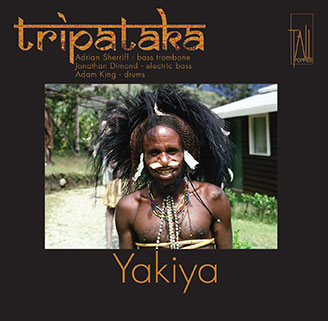
 musician
musician
“One of the most talented musicians i've ever had as a student ... highly proficient on electric bass.”Bob Moses, 1996.
TRIPATAKA: YAKIYA
TRACKLISTING
- Alt-Ctrl-X (Sherriff)
- Paco (Dimond)
- Yakiya (Sherriff)
- Mod Times (Dimond)
- Morning Star (Sherriff)
- Kosta Tszyu (Sherriff)
- A Kayak (Dimond)
- Partition (Dimond)
Album description
Recorded on the Tall Poppies label, the album captures a blend of original compositions that capture the endless inspiration the band members derive from the music of North and South India, Bali, Brazil, Cuba and many other musics from around the world. Trained in these intercultural forms as well as jazz and European classical music, the breadth of the band members’ combined experience and instrumental resources far surpasses that of a typical contemporary jazz trio.
Album Reviews
There may be only three musicians on this recording, but their combined sound is as powerful and expressive as a great big band. Polymetric drum grooves full of deep funky soul; electric bass lines that float like butterflies and sting like bees; trombone melodies singing, soaring, and diving — Tripataka’s ensemble sound is astringent, tough, and uncompromising — yet the loose authenticity of folk tradition saturates even the most complex pieces. Composition and improvisation interweave seamlessly, and the total effect is exhilarating — watch the movie inside your head while you listen, because the cinematography is terrific.Warren Senders, Boston, USA, 2017.
This is hair-curling stuff. Bass trombonist Adrian Sherriff, bass guitarist Jonathan Dimond and drummer Adam King share a keen interest in rhythmic complexities, whether by way of superimposing one rhythm atop another or incorporating metric modulation, intricate cycles or other options. The detailed liner-notes provide explanations of these convolutions, or you can ignore the mathematical underpinnings and simply immerse yourself in music that is still groove-based, but that is in constant flux.John Shand, Sydney, Australia, 2017.
Collectively they draw on wide-ranging influences including the Carnatic music of South India, flamenco and the polyrhythms of West Africa and Zimbabwe. The three players bring not only a jazz improviser’s mentality to bear in exploring and incorporating the assorted rhythmic devices, but also the precision of, say, a string trio. Among the most startling creations is Dimond’s Mod Times, which exemplifies just how engaging the melodic content can be while the grooves twist and jolt. And therein lies the point: the music is so heavily crafted from intellectual concepts that it could be forbidding, but in fact it is endlessly fascinating.
